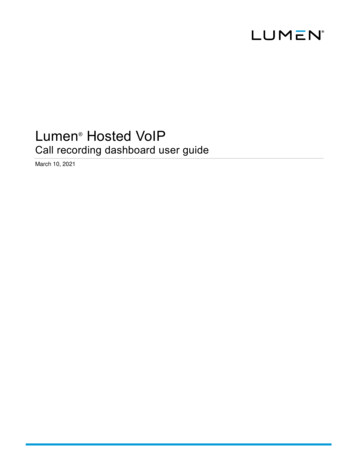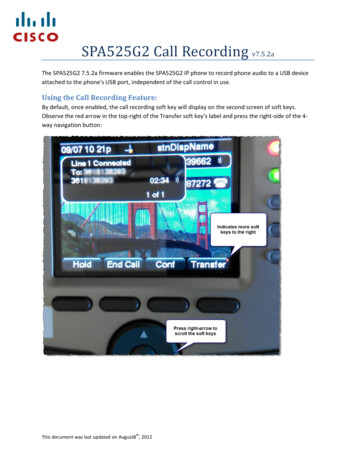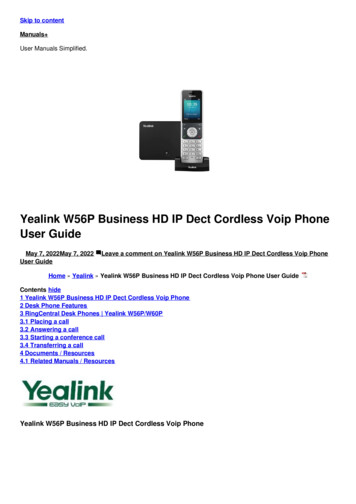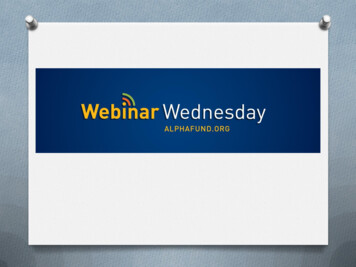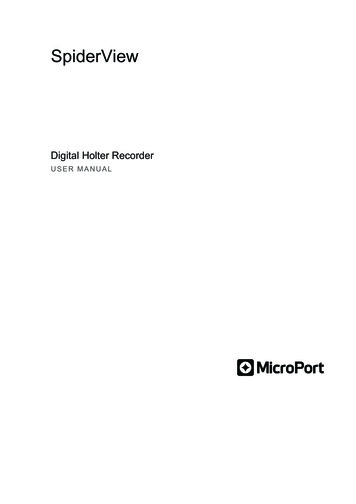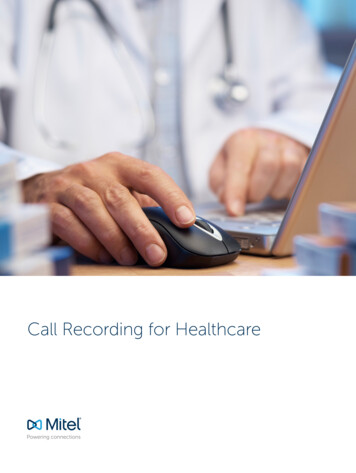
Transcription
Call Recording for Healthcare
ContentsIntroduction.3Electronic Medical Records – An Overview .3A Low Rate of Adoption . 4Voice Documents . 4How Call Recording Works .5Call Recording and EMRs .5Business Examples . 6Avoiding Common Secondary Difficulties .7Conclusion.7
IntroductionElectronic Medical Records – An OverviewFor more than a decade, healthcare operations in theSimply stated, an Electronic Medical Record is a medicalUnited States have been urged by oversight bodies andrecord in digital format. These can include documentsrelated industries to migrate from the traditional paper-such as patient care notes, treatment records, billingbased method of record keeping to paperless or electronicstatements, etc.; images such as x-rays and MRI outputs,documentation.or any other piece or type of patient information that isAs with any change in how business is conducted andservices are rendered, this has presented numerouselectronically created or transmitted from one authorizedparty to another.challenges to the healthcare industry. Electronic medicalAdvantages of electronic records over traditionalrecords, called EMRs and often interchangeably referredmedia include ease of collaboration among medicalto as electronic health records or EHRs, have taken holdprofessionals, rapid transmission of patient data, ease ofin practices and hospitals across the country, althoughstorage and retrieval, and centralization of patient-relevantimplementation has, to date, been slow and somewhatinformation.haphazard.A key advantage of electronic media over other recordWhile healthcare operations have automatedformats is accuracy. Illegibility of notes and otherinformation such as notes on patient care, billing andinformation in the medical industry has long been ascheduling, information generated from phone-basedprevalent and troublesome issue. Standardized electroniccommunications has remained largely relegated to theforms and input methods reduce illegibility and the risknotepad method used since telecommunications becameof medical error, contributing to more successful patientwidespread more than a century ago.treatment outcomes1.This document will provide background on EMRs, explorecall recording as a logical and beneficial component of ahealthcare provider’s electronic recordkeeping, discusswhy traditional EMR implementation problems do not existwith call recording and demonstrate that regardless of anoperation’s degree of EMR deployment, call recording canbe added immediately to any office without interference orprocedural disruption.Mitel 3
A Low Rate of AdoptionOther EMR DifficultiesUnlike other industries that create extensive volumesIn addition to the national-level difficulties delayingof data, such as insurance and finance, the medicalwidespread adoption of EMR systems, there also exist aprofession has been slow to adopt electronic recordshost of practical, operations-level concerns that have notmanagement systems. As of 2005, only one-quarter ofbeen adequately addressed across the board.primary physicians’ offices had implemented a completeEMR solution2.There are many reasons for the industry’s hesitancy,including:These concerns include, but are by no means limited to: Sharing records between offices or facilities Information access authorization Adequate hardware resources Interoperability challenges between systems Set-up and maintenance costs Lack of standardization Resistance to change High software costs Concerns of liability and information ownership System complexity and installation difficulty Ensuring information is unalteredThe US Veterans Administration’s VistA EMR system isVoice Documentscurrently the largest in the nation. Using what is known asthe Bidirectional Health Information Exchange protocol;the system is in use in all VA hospitals and has beentargeted for integration in all Department of DefenseThe benefits to a healthcare organization of convertingpaper records to electronic formats are well-documentedboth in terms of operational efficiency and patient care.healthcare facilities.However, until now no effective solution has existedIn addition, the protocol has been made available forinteractions.download and use by non-VA-affiliated practices aswell. For operations not using BHIE, there are currentlymore than 25 vendors of EMR systems in the US, withvarying degrees of interoperability between systems3.Medical operations using the same or compatible systemsexperience significant benefits in billing accuracy andreduced service duplication. However, as noted, few ofthese systems can actually communicate with each otherdirectly.Contributing to low interoperability is a lack ofestablished standards. At present, there are at least ninestandardization bodies and eight proposed set of standardscovering various aspects of healthcare operations4.to apply those same benefits to telephone-basedIn a busy medical office, it is exceedingly difficult tocreate and maintain adequate paper notes on telephoneconversations. Writing notes by hand or typing them ona keyboard by necessity leaves out content and creates ahigh potential for error.Call centers in medical-related fields, such as insurance,have used call recording technology for years to reducetheir liability, ensure accuracy and evaluate agentperformance. These solutions have been of great benefitin charting call volumes, training agents, resolving disputesand, in general, maintaining efficiency on an organizationwide level. Unfortunately, this “top-down” approach wasnot easily portable to employees and staff dealing withday-to-day information and patient interactions in thehealthcare office itself.Mitel 4
Mitel’s MiVoice Call Recording software provides medicalMitel’s MiVoice Call Recording software is deployedoffices with a complete solution to simply and efficientlyvia an appliance or server-based delivery model, withdocument telephone conversations with patients,hardware and software working in tandem to seamlesslyinsurance companies and other healthcare providers. Theintegrate with business telephone systems. The softwaresolution is specifically designed to aid medical practicesallows calls to be captured and stored as searchable,with improving cash flow, monitoring processes andplayable electronic voice documents. Now, rather thanpatient service, and eliminating errors in communication.merely inserting notes into a file, the call is documentedMiContact Center Quality Management, the contactand stored in its entirety and can be organized intocenter management software from Mitel, delivers the samean electronic folder, searched for and retrieved by acapabilities of MiVoice Call Recording, but with additionalcombination of any number of search criteria, annotatedadvanced features including live call monitor, reports,and shared with those inside and outside the organizationevaluations, and desktop screen recording capabilities.via a secure link.Rather than making call recordings available only toCall Recording and EMRscontact center managers, Mitel solutions create a voicedocument individual users can refer to, play back, andshare with others they authorize. They can highlightportions of the call, insert comments for supplementalinformation, and provide a link to the call to anotherhealthcare provider, billing agent, or facility to ensurepatient needs are met.How Call Recording WorksHealthcare offices handle countless telephone calls everyday. Unless those calls are transcribed immediately byBy now it should be easy to see how Call Recording fitsinto an overall EMR strategy. Similar to replacing paperdocuments with electronic records, storing telephoneconversations as voice documents facilitates easycollaboration; makes telephone conversations rapidlytransmittable to other authorized users; reduces timefor lookup and retrieval; and produces records that aresecurely stored on a centralized device. Voice documentsare inherently 100 percent accurate, providing informationexactly as it was originally generated.a trained stenographer, the only information remainingafterward is whatever notes the assistant, nurse ormanager handling the call may have jotted down. Evenif a stenographer is used, tone of voice and other usefulsubtext information is still absent.Mitel 5
Unlike the multitude of EMR solutions available fordocuments and images, voice documents do not sufferchallenges in interoperability or standardization. To sharea voice document, one simply identifies an authorized userand provides that person with a link to the needed voiceBusiness ExamplesCall Recording functionality can have an immediate impacton healthcare operations; consider the following twoeveryday situations as examples.document. Permanent system users will receive the linkA patient calls their physician’s office to schedule anin their voice document inbox along with a helpful visualappointment. A staff member then calls the patient’srepresentation depicting all related data such as the partiesinsurance provider and receives pre-authorization forof the call, comments, etc.the visit. The patient arrives, receives service and leaves.Temporary guest users will receive an e-mail with a linkto the Call Recording system. Upon clicking the link, theWhen the billing cycle occurs, the insurance providerdenies a portion or even the entire amount of the claim.voice document plug-in downloads to their machine,With MiVoice Call Recording functionality, the originalallowing them to access only the shared voice document.telephone call is automatically organized into a folderThis is especially useful for those recipients outside thespecific to the insurance provider based on the numberpractice, facilitating improved communications betweenthe staff dialed to make the call. The user now only needsorganizations such as insurance companies, pharmaciststo locate the call within that search folder, replay the calland other medical providers. All recipients need is ato verify the pre-authorization and then share a link toWindowsTM XP or Vista computer with Microsoft .NETthat voice document with the insurance provider’s claimsframework 2.0 installed.manager.It should be noted that an external recipient never receivesThis all-too-common situation dealt with by medicalan actual copy of the voice document, only an accessoffices is handled easily and efficiently, and because of thelink. Recording playback is performed using encryptedundisputable verification provided by the voice document,media file streaming rather than by download. Theappropriate payment from the insurance provider can nowvoice document and its content never leave the centralbe expedited.repository, providing security for the record itself.In another situation, a patient may need specialized care,Since Mitel’s software works in a self-containedsuch as an imaging procedure. The physician’s staffenvironment using .NET technology, there is no concernschedules an appointment for the following Tuesday atregarding outside standards. Rather than worrying about11am, but when the patient arrives at the imaging lab, theyintegrating Call Recording into a separate EMR solution,have no record of the patient on the schedule. The patientit can be considered as running parallel. All an officethen calls the doctor’s office, upset that they have takenneeds is a business phone system, an IP data network, andthe morning off from work for the procedure.Windows on the desktop. There is not implementation lagor concern about cross-compatibility.A staff member at the doctor’s office can rapidly retrievethe voice document of the scheduling call to confirmA significant differentiator between Mitel’s solutionsthe time. If the scheduling error was made by the lab,and EMRs for documents and images is the low cost ofthis can be quickly and simply communicated by sharingimplementation and ease of installation of a Call Recordingthe voice document with the scheduling staff at thesystem. Mitel’s software delivery methods are extremelyimaging lab, who, based on their error, should attempt tocost effective, and most installations are completed in lessaccommodate the patient and find a way to work themthan four hours when handled by a trained technician.into the schedule.Unlike many document and image-based EMRsolutions, Mitel’s solutions avoid the four main pitfalls ofinteroperability, standardization, software cost, and systemcomplexity.Mitel 6
Avoiding Common Secondary DifficultiesNoted previously were seven secondary difficulties that have slowed adoption of document and image-based EMRsolutions. The table below demonstrates how Mitel’s solutions easily overcome these obstacles and bring immediatevalue to healthcare offices.DifficultyMitel SolutionsSharing records between offices orfacilities.»» Simply identify an authorized user and share a link to the voice document.Information access authorization»» Mitel permissions-based architecture inherently manages access authorization.Adequate hardware resources»» The Call Recording solution is a self-contained system and the user experiencerelies on standard Windows desktop systems.Set-up and maintenance costs»» Mitel solutions are provided as a one-time purchase with low ongoingmaintenance costs for both hardware and software.Resistance to change»» Mitel solutions offer an intuitive interface based on Microsoft OutlookTM, whichis already familiar to most users.Concerns about liability andinformation ownership»» The inherent 100 percent accuracy of a voice document eliminates accuracybased liability concerns. Under HIPAA, patients own their EMRs. With MiVoice CallRecording, those records are easy to provide to patients should they be requested.Ensuring integrity/authenticity ofinformation»» Voice documents are securely stored on a central repository and use a dedicatedfile format paired with digital watermarking, making them extremely difficult to alter.ConclusionUntil the introduction of MiVoice Call Recording, a vital component of patient electronic medical record needs wentunaddressed. Today, regardless of how much progress a healthcare provider may have achieved in deploying EMRs fortheir document and imaging-based records, they can immediately deploy call recording to satisfy the telephone-basedrecord keeping needs of their operations and, most importantly, their patients.mitel.com Copyright 2015, Mitel Networks Corporation. All Rights Reserved. The Mitel word and logo are trademarks of Mitel Networks Corporation.Any reference to third party trademarks are for reference only and Mitel makes no representation of ownership of these marks.6050-16108-123456-R0315-EN
manager handling the call may have jotted down. Even if a stenographer is used, tone of voice and other useful subtext information is still absent. Mitel's MiVoice Call Recording software is deployed via an appliance or server-based delivery model, with hardware and software working in tandem to seamlessly integrate with business telephone .

